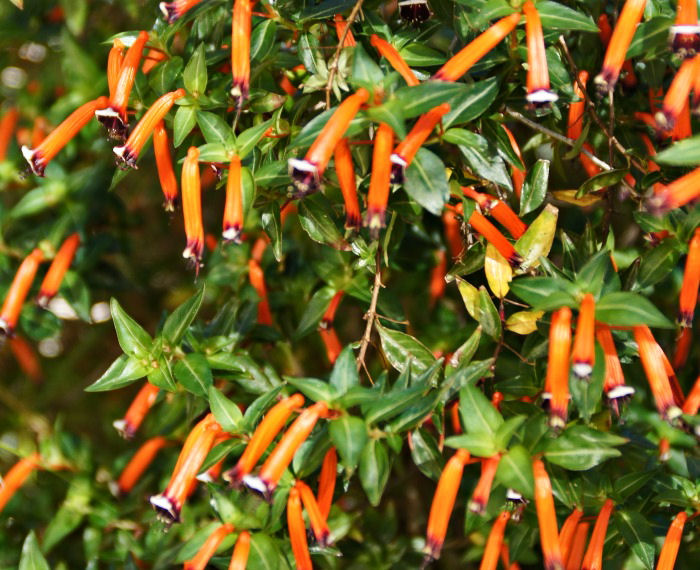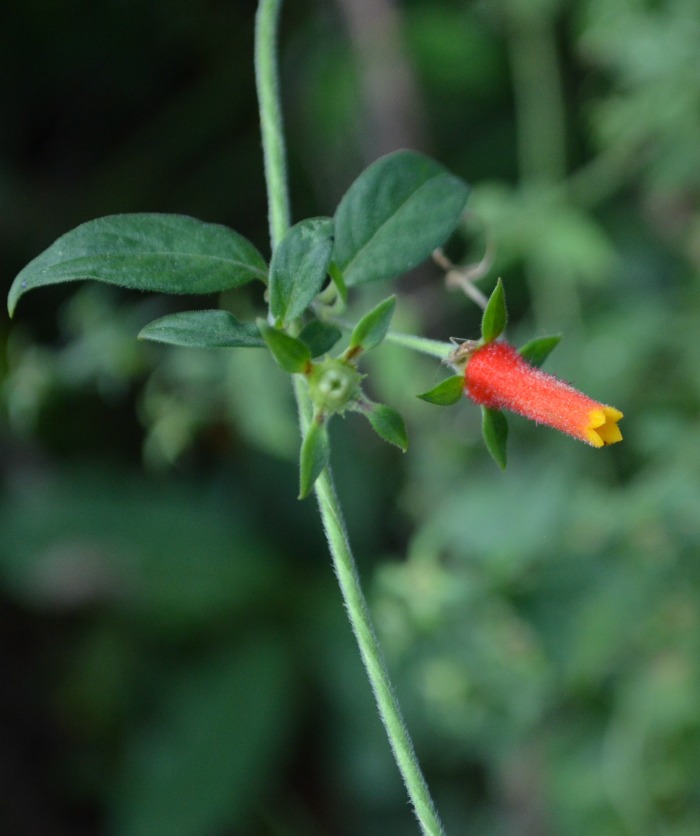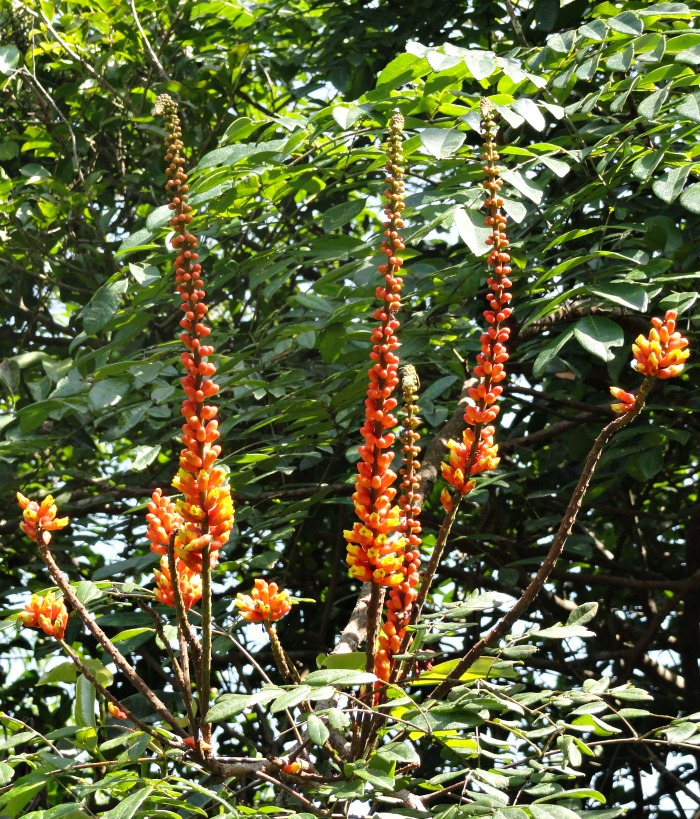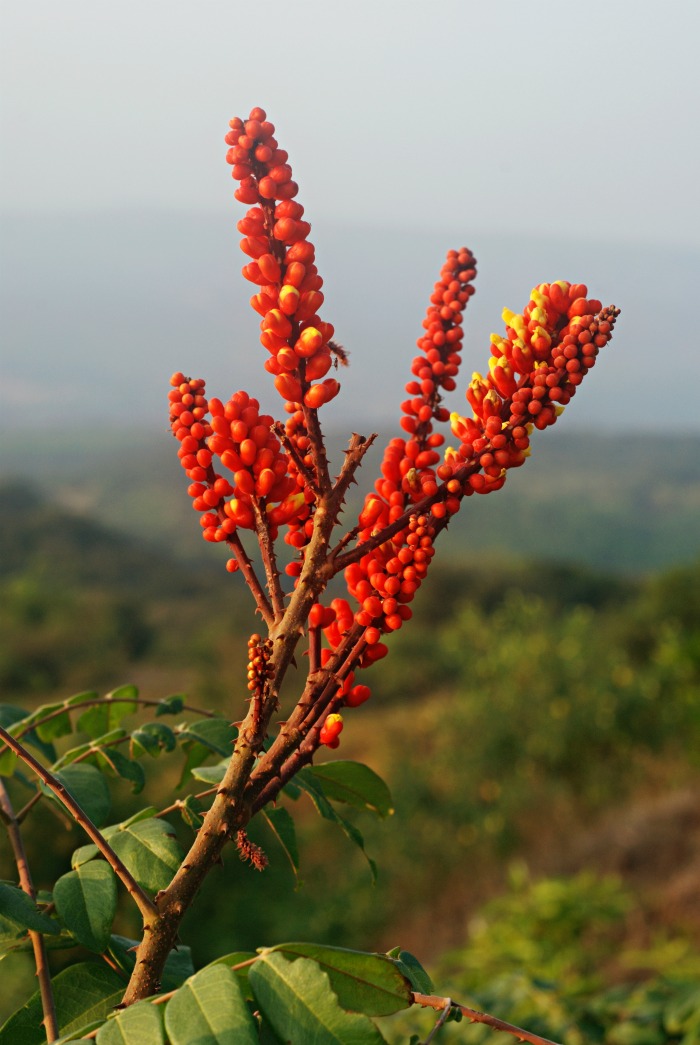The common name of this pretty perennial says it all – candy corn plant has blooms that look quite similar to the popular candy that we love to eat in the fall!
It wouldn’t be fall without a candy corn martini, or a candy dish or two loaded with candy corn. Good news for gardeners – we can enjoy candy corn in our garden too!
This plant is the perfect choice to add to your garden for Halloween. In fact, it is just one of the plants included in my list of Halloweeen plants.
Let’s find out all about this interesting plant for fall.

What is cuphea micropetala?
This variety of the candy corn plant is a member of the cuphea genus of plants. It is native to Mexico. The family includes over 250 perennials and shrubs that are found in tropical and temperate regions.
- Genus: Cuphea
- Species: micropetala
- Family: Lythraceae
- Life Cycle: Tropical perennial in zones 8-11, annual in cooler climates.
In addition to cuphea micropetala, there are other plants with the same common name. You can find them all at the bottom of this post.
As an Amazon Associate I earn from qualifying purchases. Some of the links below are affiliate links. I earn a small commission, at no extra cost to you, if you purchase through one of those links.
Candy corn is not just for eating! Did you know that there is a garden plant called candy corn plant? Find out how to grow it on The Gardening Cook. Click To TweetTips for growing candy corn plants
These easy care plants with the fun colors of candy corn are a delight in the garden. They need plenty of sunlight and very little care during the growing season.
Read on to find out how to get the most out of your candy corn plants. I am giving care tips for cuphea micropetala, but the other candy corn plants have similar requirements.
Sunlight needs for this tender perennial
Grow candy corn plant in full sunlight to get the most flowers. Cuphea micropetala is suited to beginning gardeners, since the plant requires little care beyond a warm, sunny spot in your garden.
This pretty plant will grow in more shady spots, but you won’t get as many flowers.
When to plant candy corn plant
You’ll have the best success if you plant candy corn plant in the spring after the danger of any frost has passed. This allows the young plant time to become established before the hot heat of summer gets going.
The plant likes average, well draining soil with a slightly acidic pH of 5.5 to 6.5.
Fertilizing the plant is not necessary and can result in lots of leaves but fewer flowers. Candy corn plant does benefit from a dose of compost around the plants in the spring.
How often should I water cuphea micropetala?
After planting, water the young plants regularly to get them established. Once they are acclimated to your garden, you can hold back on the watering.
Candy corn plant is quite drought tolerant. All you need in the growing season for established plants is an inch of water a week! Cuphea micropetala will not tolerate wet soils.
Size of mature specimens
Candy corn plant is a shrubby, plant that can reach heights of up to 3-4 feet tall with a 2 foot spread at maturity.
The plant has an arching and clumping habit and is rounded in shape.
Flowers of the candy corn plant
Gardeners are drawn to this pretty perennial because of the cute common name and the bright, orange and yellow flowers that remind us of candy corn. The bi-colored flowers definitely look like one of your favorite Halloween treats!
The flowers of cuphea micropetala are tubular and 1 to 3 inches long. The common name candy corn plant is due to the fact that the flowers are bi-colored, orange near the stem and yellow towards the tips – just like the popular candy.
The plant has narrow leaves on upright red stems and enjoys a long bloom season, flowering in summer through to fall.
If you are growing the plant in warmer hardiness zones, cut back the plant in late winter to encourage a flush of new growth the following spring.
The plant can get leggy in summer. Pinching it back will result in better blooms.
Hardiness zones for candy corn plant
The plant grows as a perennial in warm weather hardiness zones 8 to 11. It can be grown as an annual in cooler climates.
In the warm hardiness zones, candy corn plant is often grown as an evergreen shrub. In these zones, the plant typically will die back when temperatures drop to the 20’s and will recover in late spring as the temperatures start to rise again.
There are several varieties of the cuphea genus, but cuphea micropetala is one of the most cold-hardy.
Propagating cuphea micropetala
Getting new plants for free is always a pleasant gardening experience. Luckily, there are several ways to get more candy corn plants for your own garden or to share with a friend.
Candy corn plant is propagated by division. The plants can get woody after a few years and division will also help this. Cuphea micropetala can be grown from seed and also from leaf and stem cuttings.
You will have best luck with softwood cuttings taken from plants in the spring. Make a cutting about 4 inches long on a stem with no flowers and insert the stem into moist potting soil.
Keep the cutting in a shady location and be sure it is kept evenly moist until roots develop. This can take about 6 weeks.
For gardeners who like to grow plants from seed, collect seed heads when the flowers fade and allow them to dry.
Uses in the garden
Grow cuphea micropetala in all sorts of garden settings, from rock gardens to cottage gardens. The plant is great in a cutting garden and the showy tubular flowers attract butterflies as well as pollinating insects.
If you don’t get much rain in your garden, you will love candy corn plant. Once established, it is quite drought tolerant. It also does not mind dry soil and low humidity.
The plant is nice used as mass plantings, as a border plant and in small groups.
Candy corn plant can also be grown in containers as a patio plant. It usually grows too large to be useful as an indoor plant.
Varieties of candy corn plants
Cuphea micropetala is closely related to several other plants with similar flowers. Some belong to the same family and others are another species, entirely. Here are the differences.
Cuphea ignea
The variety Cuphea ignea, also known as cigar plant, has a similar size and flower shape as candy corn plant. The main difference between the two is the flower color.
At first glance, one might think the plants are the same, but look again! Cigar flower looks more like a burning ember at the tip of the flower, with a warm red color but no color hues like those found in candy corn plant.
Manettia luteorubra
The plant should also not be confused with candy corn vine – manettia luteorubra. 
Although the flowers are quite alike in these two plants, the candy corn vine comes from an entirely different species with a much different growth habit. It is native to South America.
Manettia luteorubra is a vining plant that is suitable as a ground cover or used for climbing a trellis. The vines can grow to 15 feet long.
Moullava spicata
Large and robust, moullava spicata has branches that have curved prickles on them. The colorful flowers come in dense spikes at the end of the branches.
The flowers are scarlet and yellow, but they do not fully open. This plant is native to India and is also known as candy corn plant.
To me, this variety looks very much like our favorite candy!
Cuphea melvilla
If you live in chillier locals, cuphea melvilla is a variety that can take slightly cooler temperatures – down to zone 7a. This variety has the same tube shaped flowers that open up like firecrackers along the branching stems. The plant is semi woody and can grow up to 4 feet tall with an equal spread.
This variety has the same tube shaped flowers that open up like firecrackers along the branching stems. The plant is semi woody and can grow up to 4 feet tall with an equal spread.
Wagatea spicata
Another vining variety, wagatea spicata also has the common name candy corn plant. It can grow to 8-10 feet tall. The plant has spines or sharp edges so caution should be taken when when handling.
This vine is a prolific bloomer that has flowers from late spring to late fall. This climbing candy corn plant has large marble-sized seeds on woody stems which really have the look of candy corn when the yellow color pokes through.
Where to buy candy corn plants
If you live in the warmer hardiness zones 8 -11, you may be lucky to find your plant locally at a garden center, your local Farmer’s Market, or one of the big box stores.
For those who live in cooler climates, you can purchase candy corn plants online at various retailers.
- Find candy corn plant – cuphea micropetalata – on Etsy.
- Purchase cigar plant – cuphea ignea – on Etsy.
- Etsy also has seeds for moullava spicata.
Whichever candy corn plant you choose, the blooms are the perfect way to bring the color of candy corn to your garden each year. Now, if only they would actually grow candy corn, they would be the perfect all round plant!
Pin these tips for growing cuphea micropetala for later
Would you like a reminder of these tips for growing candy corn plant? Just pin this image to one of your flower boards on Pinterest so that you can easily find it later.
You can also watch the video on YouTube.

Growing Candy Corn Plant

Candy corn plant is a tender perennial that has two-toned orange and yellow tubular flowers that hummingbirds and pollinators love. The color of the flowers resemble our favorite fall candy.
Materials
- 1 candy corn plant
- Compost
Tools
- Spade
- Hose or watering can
Instructions
- Choose an area with full sunlight and well draining soil.
- Plant in spring when the danger of frost has passed.
- Add compost or other organic matter when planting and again each spring if the plant has overwintered.
- There is no need to fertilize candy corn plant.
- It grows as a perennial in cold hardiness zones 8-11.
- In colder zones, treat it as an annual. If the winters are mild, it might survive in zone 7 with mulching.
- The plant will grow to 4 feet tall and 2 feet wide. It has a clumping habit.
- Pinch back blooms to encourage more flowers.
- Bloom time is summer through to fall.
- Great for cutting gardens and patio containers.
- Attractive to hummingbirds and pollinators.
- 1 1/2 inch flowers are orange and yellow and look like candy corn.
- Propagate by division, seed and cuttings.
Recommended Products
As an Amazon Associate and member of other affiliate programs, I earn from qualifying purchases.




